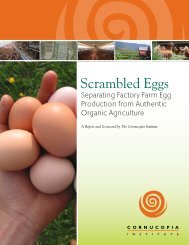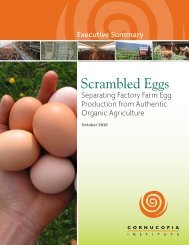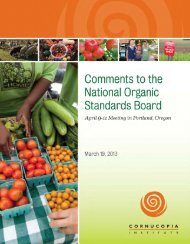“Behind the Bean” (pdf) - Cornucopia Institute
“Behind the Bean” (pdf) - Cornucopia Institute
“Behind the Bean” (pdf) - Cornucopia Institute
Create successful ePaper yourself
Turn your PDF publications into a flip-book with our unique Google optimized e-Paper software.
Commitment to Avoiding Genetically<br />
Engineered Organism Contamination<br />
Genes do not function in isolation in any organism. Ra<strong>the</strong>r, <strong>the</strong>y interact with and influence each o<strong>the</strong>r. When<br />
genes are manipulated by genetic engineering or conventional breeding, <strong>the</strong>se interactions can lead to unintended<br />
side-effects that alter traits o<strong>the</strong>r than <strong>the</strong> intended one. 17<br />
—Union of Concerned Scientists<br />
In 2008, 92% o f s o y b e a n s grown in<br />
<strong>the</strong> United States were genetically engineered.<br />
In states such as Iowa and<br />
Indiana, <strong>the</strong> percentage is even higher—95%<br />
and 96%, respectively. 18 This<br />
is a tremendous increase since 2000,<br />
when 54% of U.S.-grown soybeans were<br />
genetically engineered—an impressive<br />
level of adoption, considering genetic<br />
engineering of soybeans is a relatively<br />
new technology. 19<br />
Photo source: istock.com<br />
Today, genetically engineered soybean<br />
plants and heavy pesticide use go hand in<br />
hand—not exactly part of a sustainable<br />
agricultural system.<br />
Nearly all genetically altered soybeans are engineered<br />
to be tolerant to <strong>the</strong> herbicide glyphosate,<br />
marketed as Roundup ® by Monsanto. 20<br />
This allows farmers to spray <strong>the</strong>ir fields with<br />
this herbicide, killing weeds without killing <strong>the</strong><br />
Roundup Ready ® soybean plants. Farmers planting<br />
genetically engineered soybeans are only allowed<br />
to use Monsanto’s Roundup—not a less<br />
expensive generic version of <strong>the</strong> herbicide glyphosate—on<br />
Monsanto’s genetically engineered<br />
soybeans. This assures Monsanto that farmers<br />
will continue to purchase <strong>the</strong>ir herbicide.<br />
Farmers are not only required to use Monsanto’s proprietary version of glyphosate, but <strong>the</strong>y are also bound by a “technology<br />
agreement” that <strong>the</strong>y are required to sign, which prohibits <strong>the</strong>m from saving seed from <strong>the</strong>ir crop to use <strong>the</strong> following<br />
year. When “adventurous” genes have contaminated some farmers’ crops, even when <strong>the</strong>y have not planted genetically<br />
engineered seed, Monsanto has successfully sued <strong>the</strong>se farmers for patent infringement.<br />
Consumers should not be fooled by claims that genetically engineered crops and sustainable agriculture can go hand in<br />
hand. For example, studies have shown that <strong>the</strong> planting of Roundup Ready crops does not lead to reduced herbicide use.<br />
In fact, according to a report by agronomist Charles Benbrook, “between 1996 and 2004, farmers used 138 million more<br />
pounds of herbicides on genetically engineered varieties than on conventional ones.” 21 This is partly due to <strong>the</strong> emergence<br />
of herbicide-resistant “superweeds.” According to <strong>the</strong> report, “As weed scientists have predicted for years, <strong>the</strong> widespread<br />
use of glyphosate on millions of acres of GE crops has selected for weeds that are tolerant to <strong>the</strong> chemical. These new weeds<br />
are subdued only by multiple applications of glyphosate and/or o<strong>the</strong>r herbicides.” Some farmers are forced to use what <strong>the</strong>y<br />
referred to as a “chemical cocktail” in order to subdue <strong>the</strong> resistant weeds. Today, genetically engineered soybean plants and<br />
heavy pesticide use go hand in hand—not exactly part of a sustainable agricultural system.<br />
14 Behind <strong>the</strong> bean: The Heroes and Charlatans of <strong>the</strong> Natural and Organic Soy Foods Industry.





